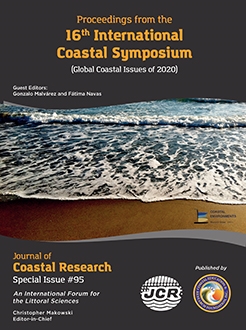Moulton, M.A.B.; Hesp, P.A.; Miot da Silva, G.; Keane, R., and Fernandez, G.B., 2020. Effects of the increase in vegetation cover and impact of rabbits on the geomorphology of parabolic dunes (Younghusband Peninsula - SA, Australia). In: Malvárez, G. and Navas, F. (eds.), Global Coastal Issues of 2020. Journal of Coastal Research, Special Issue No. 95, pp. 108-112. Coconut Creek (Florida), ISSN 0749-0208.
This study examines the geomorphological changes that occurred in a large parabolic dune on the Younghusband Peninsula (YP) dune system (South Australia) due to changes in vegetation cover in the past ∼70 years. Recent studies have shown that vegetation cover has significantly increased due to the control of exotic rabbits by introducing Myxomatosis (1950's) and Rabbit Haemorrhagic Disease Virus (1990's and 2000's). Using a sequence of historical aerial photographs between 1949 and 2018 and LiDAR data (2018), changes in the geomorphological evolution of a typical parabolic dune were analyzed. In 1949 a well-developed transgressive and parabolic dunefield connected to the beach was present. In 1975 (26 years later), the parabolic dune analyzed here experienced partial stabilization by the increase in vegetation cover on the deflation basin and on top of the depositional lobe, where nebkha dunes started to develop. Vegetation of the nebkha eventually connected to the vegetation of the deflation basin, separating the parabolic dune into two. In 2018, a major stabilization of parabolic dunes, now disconnected from the beach by high foredunes, together with an increase of vegetation in the nebkha fields, deflation basin and in the interdune depression were observed. Although a gradual reduction in bare sand area within the parabolic dune and deflation basin was observed, demonstrating a clear stabilization process in the period analyzed, a significant increase in dune migration rate was observed between 1984 and 1995 (9.6 m/y), with was only acceded by the initial period 1949-1956 (14.6 m/y). These two periods correspond to times when European rabbit populations were highest in the YP, suggesting that these exotic herbivores played a significant role in the geomorphological evolution of parabolic dunes.





